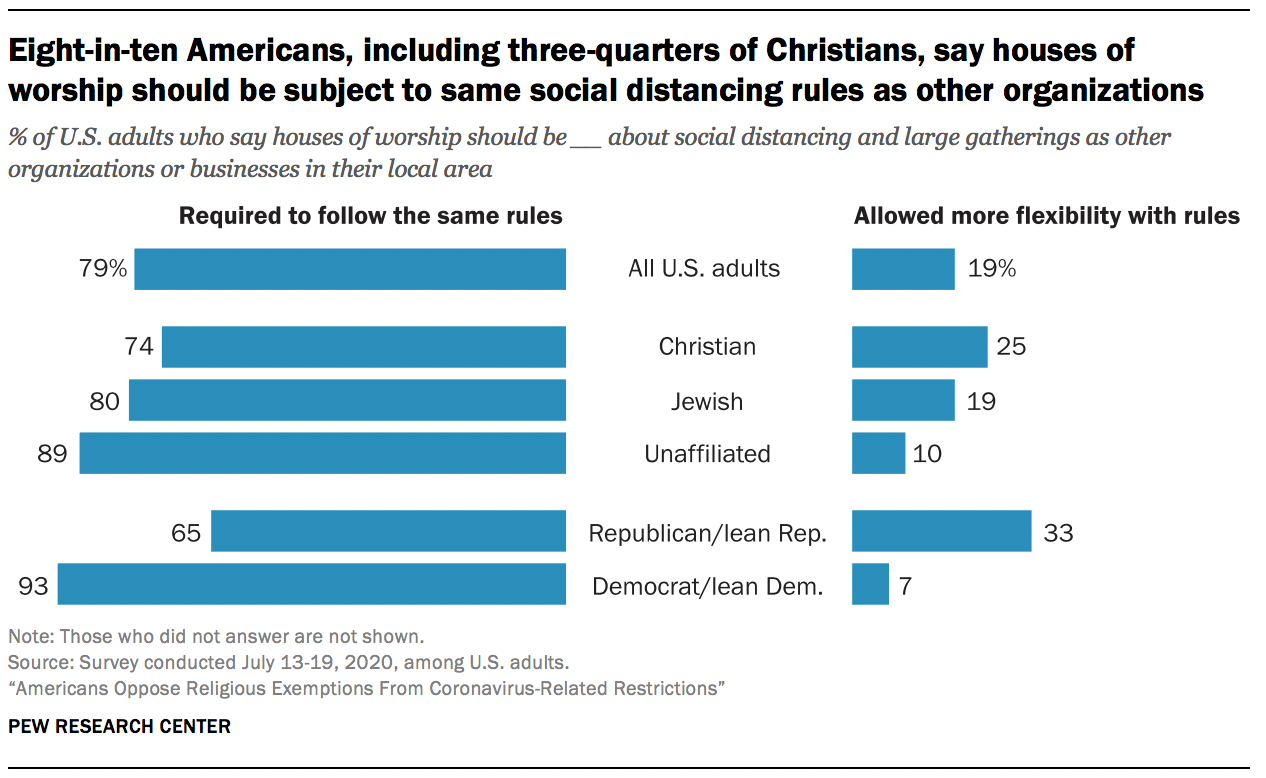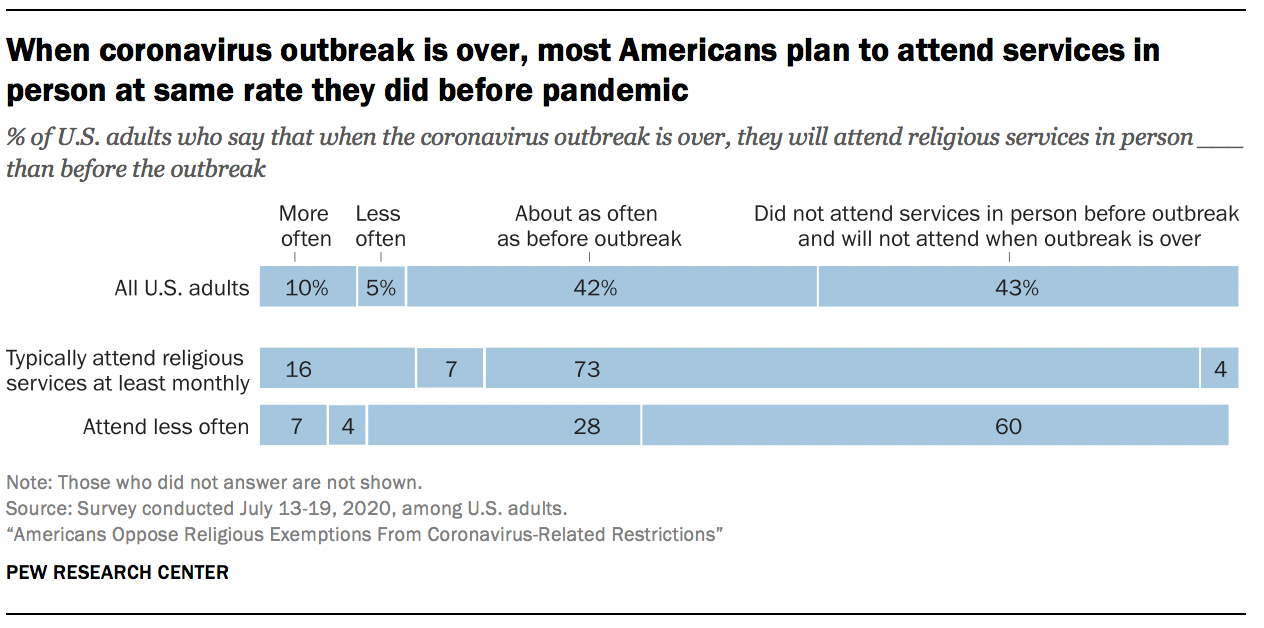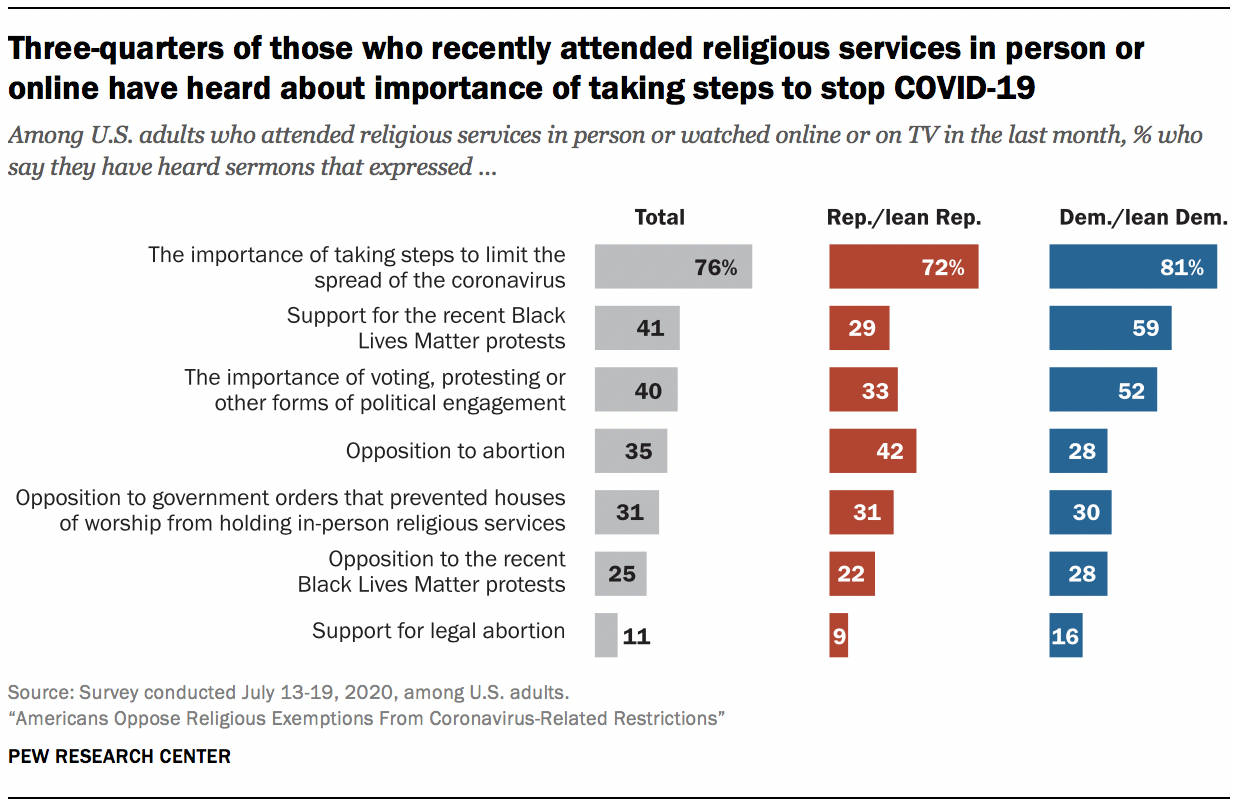

Pew Research Center conducted this survey to help understand how the coronavirus outbreak has impacted the worship habits of Americans. For this report, we surveyed 10,211 U.S. adults from July 13 to 19, 2020. All respondents to the survey are part of Pew Research Center’s American Trends Panel (ATP), an online survey panel that is recruited through national random sampling of residential addresses. This way nearly all U.S. adults have a chance of selection. The survey is weighted to be representative of the U.S. adult population by gender, race, ethnicity, partisan affiliation, education and other categories. For more, see the ATP’s methodology and the methodology for this report.
The questions used in this report can be found here and here.
A new Pew Research Center survey finds that U.S. adults overwhelmingly say houses of worship should be required to follow the same rules about social distancing and large gatherings as other organizations or businesses in their local area. About eight-in-ten Americans (79%) take this position, four times the share who think houses of worship should be allowed more flexibility than other kinds of establishments when it comes to rules about social distancing (19%).
On this question, Americans seem to align with two recent Supreme Court orders, which rejected lawsuits claiming that state restrictions on worship violated the First Amendment’s guarantee of religious freedom. At the same time, many state and local governments have carved out exemptions for religious institutions from pandemic-related restrictions.
Among U.S. Christians, about three-quarters say churches should be subject to the same rules as other businesses. Evangelical Protestants express the most support for giving houses of worship more flexibility, but even in this group, a 62% majority says houses of worship should be held to the same standards as other businesses and organizations (see Chapter 1 for more details). And while Democrats and those who lean toward the Democratic Party are substantially more likely than Republicans and Republican leaners to say houses of worship should be required to follow the same social distancing rules as other organizations, a two-thirds majority of Republicans also express this view.

In addition, amid reports that some clusters of the virus have been tied to religious gatherings, many Americans who regularly attend religious services express support for instituting a variety of restrictions and modifications at their own places of worship. At the time the survey was conducted (July 13 to 19), only 13% said their house of worship should be open to the public just as it was before the outbreak.1


More than eight-in-ten attenders think their own congregation should either be closed altogether (28%) or open only on a modified basis (57%), with this latter group broadly endorsing precautions such as requiring people to stay 6 feet away from each other (51%), requiring masks (44%), limiting the number of people in attendance at any one time (41%) and limiting communal singing (29%).
These figures are largely in line with what religious attenders say is actually going on at their congregations. Just 6% say their congregation is open to the public in the same way it was before the coronavirus outbreak. A majority (55%) say that the house of worship they attend most often is open to the public for religious services on a modified basis as a result of the coronavirus outbreak, while three-in-ten (31%) say their house of worship is closed altogether.
Meanwhile, the vast majority of religious attenders (79%) say their house of worship is streaming or recording its religious services so people can watch online or on TV.
Among those who attend religious services, mainline Protestants and members of the historically Black Protestant tradition are more likely than Catholics and evangelical Protestants to say they think their congregations should be closed. Most Catholics and evangelicals think their churches should be open, albeit with restrictions in place (see Chapter 1 for details). Similar patterns are reflected in the current operating status of churches across these Christian traditions. (The survey included too few interviews with members of other religious groups who attend services regularly to permit separate analysis of their answers to these questions.)

Most regular attenders say they are either “very” (34%) or “somewhat” (29%) confident they could safely attend religious services in person right now, without spreading or catching the coronavirus. About one-third are “not too” (19%) or “not at all” (16%) confident they could safely attend in-person services.
Majorities of regularly attending evangelical Protestants (75%) and Catholics (59%), along with 56% of mainline Protestants, say they feel safe attending church right now. Protestants in the historically Black tradition and Hispanic Catholics, meanwhile, are more evenly divided between those who are confident it is safe to return to in-person services and those who are not.
The survey also finds broader racial and ethnic divisions on these and many other coronavirus-related questions. While nearly three-quarters of white Americans say they are confident they could safely attend in-person religious services right now, far fewer Black (49%) and Hispanic (51%) adults say the same. A previous Pew Research Center survey found that health concerns about the coronavirus outbreak are much higher among Black and Hispanic adults than among white adults, and the Centers for Disease Control and Prevention has reported that people from racial and ethnic minority groups are at increased risk of getting sick and dying from COVID-19.
But while the survey suggests that many people would feel comfortable going, far fewer Americans – 12% of U.S. adults overall – say they actually have gone to services in person in the last month (meaning the month preceding the survey, which was conducted in mid-July). Even among those who say they attend services at least monthly in more normal times, just one-third report that they attended in person during the month preceding the survey, but a far larger share (72%) say they have watched religious services online or on TV in the last month.2

Taken together, these two questions suggest that about half of U.S. adults who typically attend religious services at least once a month have replaced in-person attendance with virtual participation (at least temporarily); 49% say they have watched religious services online or on TV in the last month, but have not attended in-person religious services during this time. Roughly one-quarter (23%) of people who were regular attenders before the pandemic now say they have participated in both in-person and online or televised services in the last month. One-in-ten say they have only attended services in person and have not recently watched services online or on TV, while one-in-five (19%) have neither attended religious services in person nor have they watched online or on television.
Evangelical Protestants are more likely than members of other Christian traditions to say they recently have attended in-person religious services. But still, among evangelicals who typically attend, fewer than half (44%) say they have gone recently, while far more (80%) are watching services virtually.
These are among the key findings of a new Pew Research Center survey conducted July 13 to 19, 2020, among 10,211 U.S. adults on the Center’s online, nationally representative American Trends Panel. For more information on how the survey was conducted, see the Methodology.

The survey also finds little indication that the coronavirus outbreak will result in large-scale changes in Americans’ religious service habits in the future. More than eight-in-ten U.S. adults say either that when the coronavirus outbreak is over they will attend in-person religious services at about the same rate as they did before the outbreak (42%) or that they did not attend in-person religious services before the outbreak and do not plan to when the pandemic is over (43%). Far fewer say that when the outbreak is over, they plan to attend in-person services more often (10%) or less often (5%) than they did before the outbreak.

Plans to attend religious services more frequently after the pandemic has passed are concentrated among those who attended regularly (at least once a month) to begin with. Among those who did not regularly attend religious services prior to the pandemic, the vast majority indicate that their attendance habits will not change, largely because they did not attend before the outbreak.
The coronavirus outbreak also does not seem primed to usher in a permanent rise in virtual worship. In fact, among U.S. adults who recently watched religious services online or on TV, a larger share say that they intend to watch virtual services less often (28%) rather than more often (19%) after the pandemic passes. About half (53%) say they will watch services online at about the same rate as they did before the pandemic.
Most U.S. adults who recently watched religious services online are satisfied with services
Still, the vast majority of U.S. adults who have watched religious services online or on TV in the last month say they are “very” (54%) or “somewhat” (37%) satisfied with the services they have watched, while just 8% say they are “not too” or “not at all” satisfied.
While most regular attenders say their house of worship is putting its religious services online, the new survey also finds that Americans who are watching services online are not solely watching their own congregations.
In fact, most in this group say they have watched services offered by a house of worship that is not the one they typically attend – whether exclusively (29%) or along with services from their own congregation (30%). Four-in-ten say they have watched only their own house of worship’s services.
While virtual worship has been a new experience for many Americans during the pandemic, nearly half of those who watched religious services online or on TV in the last month (46%) say they also had done so before the outbreak.

Whether hearing sermons in person or online, many have heard about importance of taking steps to limit the virus’ spread, support for Black Lives Matter protests, importance of voting
During a year of great upheaval in the U.S., what are Americans hearing from religious leaders? Three-quarters of U.S. adults who recently attended religious services in person or watched online say that in the past few months they have heard sermons that have expressed the importance of taking steps to limit the spread of the coronavirus. At the same time, about three-in-ten have heard opposition from religious leaders to government orders that prevented houses of worship from holding in-person religious services.

In the wake of George Floyd’s killing by police in Minneapolis, about four-in-ten U.S. adults who have recently watched or attended religious services say they have heard sermons that have expressed support for the recent Black Lives Matter protests, while a quarter have heard opposition to the protests. And with a presidential election looming, four-in-ten say they have heard from clergy about the importance of voting, protesting or other forms of political engagement.
Houses of worship also continue to express their views on abortion. About one-third of Americans who have watched or attended services in the last month say they heard sermons that have expressed opposition to abortion (35%), while one-in-ten (11%) heard support for legal abortion.
Judging by their answers to the survey, Democrats and Republicans are not hearing all of the same messages at their congregations. For instance, Democrats and those who lean Democratic are substantially more likely than Republicans and adults who lean toward the GOP to say they have heard sermons that expressed support for the recent Black Lives Matter protests (59% vs. 29%) and the importance of voting (52% vs. 33%). And more Republicans than Democrats say they have heard sermons that express opposition to abortion in the past few months (42% vs. 28%).

While many people who attend religious services say they have heard about social and political issues in sermons recently, fewer say they have heard much positive or negative talk about President Donald Trump or former Vice President Joe Biden, the presumptive Democratic nominee. The vast majority of Americans who have engaged with religious services recently say they haven’t heard either support for, or opposition to, Trump (72%), and 79% haven’t heard either sentiment about Biden.
Many religious leaders may avoid discussing the candidates directly due to restrictions on involvement in political campaigns by tax-exempt organizations, including religious institutions.
Other key findings from the survey include:
- Partisans hold diverging opinions about whether and how houses of worship should be reopening, if at all. Among religious attenders, more than six-in-ten Republicans and Republican leaners (64%) say their house of worship should be open to the public for in-person services with modifications in place, compared with 48% of Democrats who say this. In fact, Democrats and Democratic leaners are roughly divided between those who think their congregation should be closed entirely (44%) and those who think it should be open with modifications (48%). The survey also shows that Republicans who typically attended worship services before the pandemic are much more likely than Democrats in the same category to have recently gone to in-person services (42% vs. 19%). Because this analysis only looks at the segments of each party that normally engage in regular religious practice, these differences are not just because Republicans in general are more religious than Democrats.
- Although older adults are at a higher risk for severe illness from COVID-19, the survey finds that older religious attenders are no more or less likely than their younger counterparts to say they feel safe attending in-person services right now. And among Americans who said in a 2019 survey that they typically attend religious services at least once a month, older adults are no less likely than their younger counterparts to say they attended in-person religious services during the past month.
- Religious attenders who are living in counties hit hardest by the outbreak (that is, counties with 100 or more COVID-19 deaths) are much less likely than those living in counties that have not been as hard hit (counties where fewer than 10 people have died of the virus) to say they have attended in-person religious services within the last month (26% vs. 47%). See Chapter 1 for details.
- Most U.S. religious attenders say they have not changed the amount of money they donate to their house of worship since the start of the coronavirus outbreak. More than half (54%) say they have donated the same amount of money they normally would have, and 17% say they do not usually donate. But among those who have changed their behavior, twice as many say they have donated less money than they normally would (18% of all religious attenders) rather than more (8%).
- About four-in-ten U.S. adults say they have helped friends or neighbors by delivering groceries, running errands or caring for their children as a result of the coronavirus outbreak. About three-in-ten say they have volunteered or made a donation through a nonreligious charitable organization, and 18% say they have done the same through a religious organization. By comparison, fewer U.S. adults say they have asked for help from others during the coronavirus outbreak. Nearly one-in-five (17%) say they have turned to family or friends for help with bills, housing or food. About one-in-ten say they have asked for help with bills, housing or food from a nonreligious charitable organization. And 6% report that they have sought help from a religious organization. See Chapter 2 for details.
- To help cope with the coronavirus outbreak, nearly three-quarters of U.S. adults (73%) say they watch TV or movies, and 57% say they spend time outdoors on a daily basis. Smaller shares say they pray (43%), talk on the phone or by videoconference with friends or family (34%), or exercise daily (34%) to help cope with the outbreak. About one-in-six say they read scripture (17%) or meditate (16%), while 2% say they do yoga (see Chapter 2).